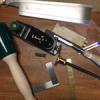I'm setting up shop in my garage. I have a cordless trim router that generates a lot of dust, a cordless circular saw I use only some of the time, a ROS sander, and the rest of the time I'm using hand tools - jack plane, smoothing plane, block plane, rabbet plane, chisels, and japanese pull saws.
I would like some sort of dust collection or vacuum, or at the least a way to suck up all the shavings at the end of the day.
I'm looking at the makita vc4710 (quiet, good suction, good reviews), but at that price point I wonder if I'm better off getting a real 1.5-2HP dust collection system. Advice?
What do other (mostly) hand tool workers use?
tia





 Reply With Quote
Reply With Quote








